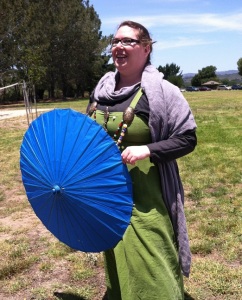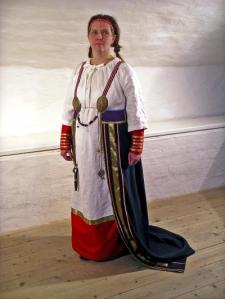Everything we know about fashion came down from our mothers, and our mothers mothers. What if we had to figure it out ourselves, based on the stuff they left lying around when they were buried?
Lucky for us, Viking age remnants leave only a little to the imagination in the field of women’s clothing. A strap goes here, a belt was probably there, lovely metal clasps held everything together here. A glorious example of the accepted style can be found here, at Dilletant where research is done before cutting starts. Here’s an example of my own mostly-historical dresses:

The umbrella and flip flops are not, as far as we know, period appropriate, but that’s the beauty of the SCA! You can see that the straps hold the brooches, which then hold a number of tools and the ever-present strings of beads and riches. Not every Viking age woman wore this type of dress, but every dress of the Viking age was similar in the amount of body it covered and layers of clothing are vital in a chilly environment. Undergarments were layered, an outer coat, cloaks, scarves and head wear in the form of wraps and hoods were de rigueur.
Another piece of the clothing puzzle is the Viking ages propensity for carving, and while they tended to carve mostly men and manly things, there are examples of women in the mix. Seen here is Mead Serving Woman, thought to be either a Valkyrie, or Freya or even Frigga herself.
 We can tell she’s wearing layers, and we can tell she’s probably got a shawl around her upper body. She appears to be wearing a tight sleeve, which we have found extant samples of.
We can tell she’s wearing layers, and we can tell she’s probably got a shawl around her upper body. She appears to be wearing a tight sleeve, which we have found extant samples of.
And then, there’s this.
A unique and deeply confusing re-imagining of the old apron-dress that highlights a sheer, lightweight indoor garment, a dragging apron attached over the nipples and held together by cording at the waist. I’ll be honest – a little more sexiness would be great in my garb. I lament at least once a month how shapeless my apron dress looks to me, when I wear the one that is closest to period accurate. Then I put on the one with tucks and darts and remember that I can bring out the sexy in anything. 😉
However, this looks like what a complete stranger to the Viking closet would do if told to go put it on with no further instructions.
Even her well-reasoned arguments fall flat. One suggestion for the low-slung brooches is that in grave finds, the brooches are found lower in the chest cavity. The authors interpretation is this: “The clasps were probably worn in the middle of each breast. Traditionally this has been explained by the clasps having fallen down as the corpse rotted. That sounds like a prudish interpretation,” says Annika Larsson.”
On top of that uncomfortable seeming explanation is her assertion that the outer layer, or apron, was sewn to the top under-dress to drape down in a train and was all meant to be showcased indoors by the fire. Having camped SCA style for years, in many flavors of garb, the last thing I want to do is be near the fire, cooking or dancing or even just hanging out, with a train dragging behind me. In the closed quarters of a longhouse, the most lascivious of trains would probably quickly be destroyed by tramping feet and moisture, and the occasional dress fire would probably sate me of my need to be overly glamorous very soon. The main concept I believe the author is working with is the Oriental-Scandinavian merging of kept women with Viking age clothing and is forgetting one important thing – there were few people who did not work. Even the lady of the farm spent her days cooking, keeping the staff at work, tending to children and animals alike. A stationary decoration sitting prettily upon her pillow would be a rare thing indeed, and the minute her perky accessories began to falter, I imagine that sheer dress and dainty train were bundled up in a shapeless apron dress, tucked under a cloak and sent out to earn her keep as another pair of useful hands.
If you’ve got a rebuttal, let me know! I love historical clothing, and the interpretations are innumerable. A lively debate is always enjoyable and sometimes educational!


